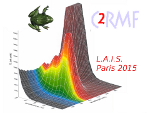Pre-Colonial irrigation canals have long been recognized in the lower Salt River valley in and around Phoenix, Arizona. Results from both radiocarbon and archaeomagnetic dating as well as ceramic typology have been used to indicate that the canals were excavated sometime between ~ 1500 to 600 years ago by the ancient Hohokam (Howard, 1991; Eighmy and Howard, 1991; Henderson, 1995). In order to reconstruct the evolution of the canals and to better understand Hohokam culture and potentially the reasons for its demise more precise age estimates are needed. This study was undertaken to determine how precisely these canal fills could be dated with single-grain optically-stimulated luminescence methods. We present here results from our pilot study in which we analyzed eight samples collected from depths of 1.0 to 4.2 m from three distinct canal fills. All analyses were conducted on single grains and final age estimates were calculated using a minimum of 131 accepted grains. Our results show equivalent doses are predominantly normally distributed, but that both overdispersion (18-35) and skewness (0.5-4.4) values are moderately elevated. These latter indications would typically suggest that we employ a minimum age model, however, those age estimates which ranged from 480 to 740 years ago, are generally younger than expected for these fills and are not stratigraphically consistent. Final age estimates were instead calculated with the central age model. Those results ranged from 750 to 1360 years ago and better agree with other available age control and are stratigraphically consistent. Two samples collected from one of the older canals identified at the site were dated at 1230 to1360 years ago, consistent with the dating of the earliest villages in the canal system. The two younger canal segments were dated between 750 to 970 (n = 3 ages) and 990 to 1040 (n = 3 ages) years ago. The former was consistent with ceramic materials incorporated in its fill. These initial results indicate that single-grain OSL dating can be used to successfully distinguish between different aged canal fills in this setting.
Eighmy, J.L. and J.B. Howard, 1991. Direct Dating of Prehistoric Canal Sediments Using Archaeomagnetism. American Antiquity 56(1):88-102.
Henderson, T. K. 1995. Land Use and Community Organization at the Head of the Scottsdale Canal System. In Archaeology at the Head of the Scottsdale Canal System, Volume 3: Canal and Synthetic Studies, edited by M. R. Hackbarth, T. K. Henderson, and D. B. Craig, pp. 145-154. Anthropological Papers No. 95-1. Northland Research, Tempe.
Howard, J. B. 1991. System Reconstruction: The Evolution of an Irrigation System. In The
Operation and Evolution of an Irrigation System: The East Papago Canal Study, by J. B.
Howard and G. Huckleberry, pp. 5.1-5.33. Publications in Archaeology No. 18. Soil
Systems, Phoenix.
- Other

 PDF version
PDF version

